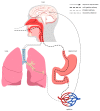Aluminium in the Human Brain: Routes of Penetration, Toxicity, and Resulting Complications
- PMID: 37108392
- PMCID: PMC10139039
- DOI: 10.3390/ijms24087228
Aluminium in the Human Brain: Routes of Penetration, Toxicity, and Resulting Complications
Abstract
Aluminium (Al) is the most ubiquitous metal in the Earth's crust. Even though its toxicity is well-documented, the role of Al in the pathogenesis of several neurological diseases remains debatable. To establish the basic framework for future studies, we review literature reports on Al toxicokinetics and its role in Alzheimer's disease (AD), autism spectrum disorder (ASD), alcohol use disorder (AUD), multiple sclerosis (MS), Parkinson's disease (PD), and dialysis encephalopathy (DE) from 1976 to 2022. Despite poor absorption via mucosa, the biggest amount of Al comes with food, drinking water, and inhalation. Vaccines introduce negligible amounts of Al, while the data on skin absorption (which might be linked with carcinogenesis) is limited and requires further investigation. In the above-mentioned diseases, the literature shows excessive Al accumulation in the central nervous system (AD, AUD, MS, PD, DE) and epidemiological links between greater Al exposition and their increased prevalence (AD, PD, DE). Moreover, the literature suggests that Al has the potential as a marker of disease (AD, PD) and beneficial results of Al chelator use (such as cognitive improvement in AD, AUD, MS, and DE cases).
Keywords: Alzheimer’s disease; Parkinson’s disease; alcohol use disorder; aluminium; autism spectrum disorder; dialysis encephalopathy; human brain; multiple sclerosis.
Conflict of interest statement
The authors declare no conflict of interest.
Figures
References
-
- Ingerman L., Jones D.G., Keith S., Rosemond Z.A. ATSDR’s Toxicological Profiles. ATSDR; Atlanta, GA, USA: 2008. ATSDR Toxicological Profile for Aluminum.
-
- Capriello T., Di Meglio G., De Maio A., Scudiero R., Bianchi A.R., Trifuoggi M., Toscanesi M., Giarra A., Ferrandino I. Aluminium Exposure Leads to Neurodegeneration and Alters the Expression of Marker Genes Involved to Parkinsonism in Zebrafish Brain. Chemosphere. 2022;307:135752. doi: 10.1016/j.chemosphere.2022.135752. - DOI - PubMed
-
- Exley C., House E.R. Aluminium in the Human Brain. Mon. Chem. 2011;142:357–363. doi: 10.1007/s00706-010-0417-y. - DOI
Publication types
MeSH terms
Substances
Grants and funding
LinkOut - more resources
Full Text Sources
Medical


